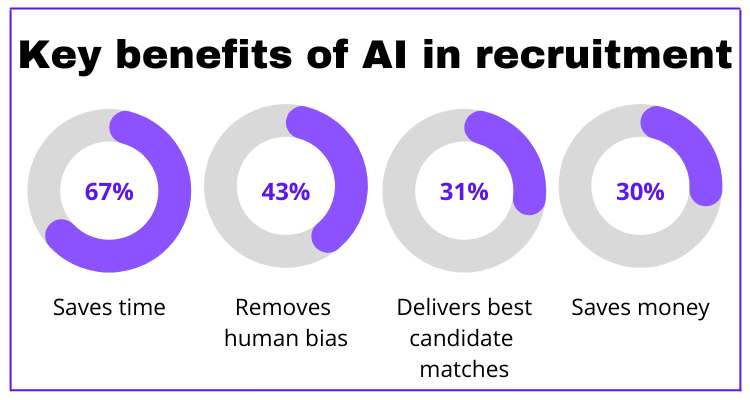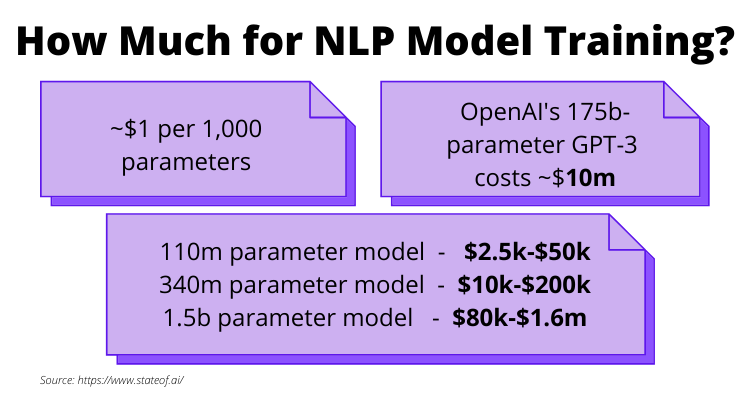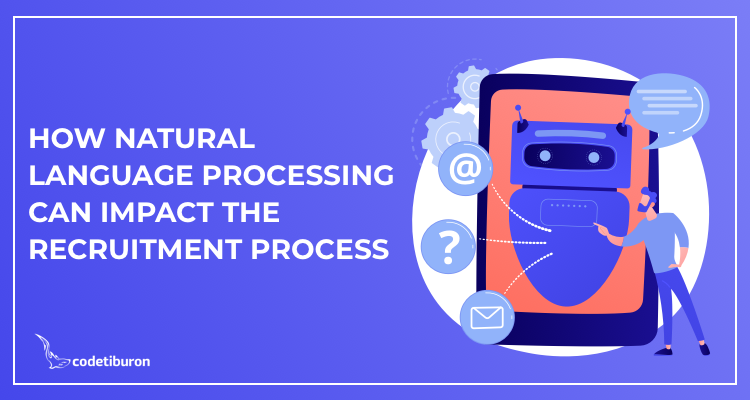‘Recruiters spend 60% of their time reading CVs… Why should a person read 300 resumes if a machine can propose the top 10?’
Hiring the right people has never been easy. Imagine doing it entirely via your laptop at the time of social distancing, economic crisis, and major workforce shift.
While recruiters and hiring managers are struggling to turn a high-touch process of recruitment into a 100% virtual journey, there is a technology ready to ease their pains.
Enter: Natural Language Processing.
In this article, we will look into the benefits, constraints, and ways to implement natural language processing into recruitment.
The plan
But first, definitions.
What is natural language processing (NLP)
NLP is a computer technology devised to make human language understandable for a machine. It employs artificial intelligence to enable successful interaction between computers and humans.
How does natural language processing work
NLP involves understanding the ties and hierarchies between individual words. Humans relate to context for meaning and responses. Machines follow elaborate algorithms of linguistic and conversational rules, unique in every language and constantly evolving.
Natural language processing combines natural language understanding (NLU) and natural language generation (NLG). Both are deemed the hardest tasks in computing due to the complexity, subjectivity, and idiomaticity of human language.
The most successful NLP methods use machine learning, which improves performance over time. Think of AI in Google that continually re-ranks search results based on people’s choices.
Just as it takes time for a human to master a foreign language, machine learning improves the analytical and conversational capacity of a program in the area of human language understanding.
How can NLP help in recruitment
NLP can enhance recruitment and HR operations in many ways. There are several application areas for natural language processing in recruitment.
Chatbots and virtual assistants
IVA’s like Siri, Alexa, Cortana have changed our day-to-day routines. Now the enterprise chatbots are expected to transform business interactions. The Gardner research states, chatbots have already been responsible for $8b cost savings annually.
Deep natural language understanding enhances search and provides an entirely new way of interaction with enterprise data. By combining content processing, ML, NLP, and voice recognition, enterprises can turn simple search-based intranets or support portals into AI-powered virtual assistants. It’s a triple benefit of reduced support costs, enhanced business intelligence, and improved brand reputation.
Intelligent document analysis
Too much of the unstructured data impairs proper analysis and prevents businesses from deriving useful insights. Intelligent document analysis uses AI techniques including NLP, entity extraction, semantic understanding, and ML to analyze content, extract meaning, and reliably aid process automation and decision making. The result is improved compliance and risk management, as well as internal operational efficiencies.
Document search and match
Most candidate search and match solutions are limited to basic resume parsing and matching corresponding metadata to a job posting. A bidirectional ideal solution however goes past a simple keyword match to theme analysis, shortlisting best applicants and jobs, keeping track of both. It combines advanced search techniques, analytics, NLP, and ML to provide statistical and linguistic capabilities for understanding applicant profiles and identifying the best candidates.
Data storage optimization analytics
Organizations need an approach for automating the migration of content to lower-cost storage while providing file-level traceability and real-time tracking of ROI. The solution is a multistep procedure, which entails using connectors to pull data from various sources, developing domain-specific business rules to help identify files eligible for lower-cost storage, archiving, or deletion. NLP and ML play a major role in automating content processing and analysis. It helps businesses track savings (potentially millions per year) and compute ROI in real-time.
Sentiment analysis
However insightful and valuable for business, opinion mining is hardly obtainable without AI. In concert, NLP technologies, text analytics, linguistic analysis, and ML can cope with the complexities of language and categorize customer sentiment. Quantitative business intelligence has harmed no one.
Insider threat detection
The average cost of an insider threat annually is $8.76 million. But on top of the monetary losses, insider threats like fraud, theft of confidential or commercially valuable information, theft of intellectual property, sabotage of computer systems – are morally and reputationally damaging. Integrating NLP-based insider threat applications gives a 360-degree view across organizational data from multiple sources, which means greater visibility, faster response, deeper insights.
Together with a huge potential for applying natural language processing in recruitment, we can see it already happening.
Some examples of NLP in recruiting

Tengai Unbiased: physical interview bot
The bot combines natural language processing (NLP) and interview analytics to assess a candidate’s soft skills and personality traits. As such, it helps get rid of (unconscious) bias, because it doesn’t take gender, age, physical or other characteristics into account.
Tengai Unbiased won the ‘Best Newcomer’ award by the 2019 National Online Recruitment Awards in the UK.
Mya: conversational AI recruiting assistant
Mya Recruit takes it a notch further and provides end-to-end guidance, from job search to onboarding. It engages candidates at scale with meaningful conversation, streamlines sourcing, screening, and scheduling. The result is reduced time-to-fill and improved quality of hire.
HireVue: NLP-aided video interview software
HireVue is arguably the best-known AI-powered hiring platform, deployed by 700+ companies, including Unilever, Vodafone, PwC, and Oracle. The platform’s AI-driven candidate assessment has brought Unilever £1M annual cost savings, a 90% reduction in time to hire, and a 16% increase in hiring diversity.
Metaview: conversation analytics
Job interviews are always a work in progress for both parties. With Metaview, hiring managers have insights at their fingertips. The technology records and transcribes interviews, highlights strengths, and provides tips for improvement. Data-driven decisions and timely feedback are just a few of the benefits.
Checkr: AI-powered background checks
Background checks have become a regular procedure in many countries. And introducing AI into background checking has its benefits:
- Bias reduction
- More privacy for applicants
- Efficiency, simplicity, and lower cost
Checkr is an innovative product that uses ML to help make the hiring and background check process more efficient.
Join.tl: automated reference checking
Just like background checks, reference checking is time-consuming and fraught with challenges – delays, missed calls, fraud. An automated process alleviates these pain points. And it gets much easier when all the data is stored in one place.
Gloat: AI for internal mobility
The benefits of internal hiring are plenty: time and cost efficiency, faster ramp-up, lower risks. Making internal mobility a priority is among the top recruiting strategies today. By applying pattern recognition and NLP on the internal data, the software creates personalized recommendations for the workforce. This, in turn, helps to boost mobility within the company. A couple of other products in this area are Phenom and Eightfold.
Teamscope: assessing team strengths and bridging talent gaps
Who doesn’t know how one bad hire can be too costly on a large scale. A shift from the individual to team level of assessment seems justified in an agile environment. The software combines data analytics with scientific testing to understand the deep-level characteristics of individuals and uses machine learning to understand how these characteristics influence collaboration and performance in a team setting. The outcome is better decisions about team performance as part of the organization’s success.
Occur: AI-powered talent marketplaces
As the gig economy grows big, many choose freelance services over long-term employment. And freelance marketplaces like Fiverr, Upwork, or PeoplePerHour are getting too crowded and – surprise! – inefficient. Too much activity is as detrimental for a network effect as too little.
Good news! The next-gen talent marketplaces are AI-driven, which shifts the search and matching responsibility to smart algorithms. The job advertisers and freelancers only get five best matches each and don’t get overwhelmed by the choice.
PayScale: determining compensation
Top-ranking companies make a special point of compensations and rewards for their employees. The problem is the notion of ‘fair’ compensation can be unclear. So many factors are at play: salary, overtime pay, bonuses and commissions, retirements, to name just a few. While larger companies have a special role to manage that, SMEs assign it to an HR generalist. For them, ‘fair’ spells PayScale, a cloud-based compensation software provider with a salary differentials engine. It gives small companies a competitive edge in surfing talent pools for hot jobs.
PeopleScout: robotic processing automation (RPA)
Process automation in recruitment can take a major load off recruiting managers throughout an entire hiring journey. Starting from sourcing and marketing campaigns through interview scheduling and chatbot deployment to post-offer activities.
Harver: rerouting candidates
Anyone looking for a job will appreciate an extra something your company can offer in the form of rerouting them to another location or position. Rather than just sitting on the resume or losing top talent, it’s always good to walk an extra mile for someone as it may return to you. Harver takes care of that in the area of retail and hospitality.
Talmundo: new employee onboarding
Onboarding is like crowning the union of two people, which leaves a lasting impression. It has to be ideal to ensure a long-standing relationship. This is where AI-driven onboarding software can make a difference by the 24/7 guidance through the new hires’ basic needs.
Another onboarding software vendor is My Ally.
What are the benefits of using natural language processing in recruitment
Among the many improvements NLP brings to the table, are a few game-changers:
- Speed of hiring. Pre-screening and sourcing tasks (the most time-consuming ones) are better off delegated to chatbots and smart resume-checking apps. Recruiters may instead give more attention to top talent.
- Source augmentation. Think of all the social platforms you can post jobs or look for talent. Balancing it all is demanding for a human but effortless for a machine once you set the criteria.
- Quality of hire. With scarce resources and high competition, the war for talent is real. Recruiters try to jump at the first promising opportunity, and so do the competitors. Extending the hiring capacity helps to boost agility and engage the top talent sooner.
And here’s how the key improvements of AI-aided recruitment look percent-wise.

How to implement natural language processing in recruitment
Together with the multiple benefits of NLP technology, its implementation requires thorough consideration.
Legal aspects
Hiring people has an ethical dimension. A recruiter makes a decision and is accountable for hiring or rejecting a candidate. Can a machine be granted the same level of accountability? And if not, who is responsible for a less-than-perfect algorithm barring 75% of candidates from the human eye? Scientists claim it’s immoral to even grant AI moral subjectivity, simply due to the elusive nature of human ethics. Therefore, implementing NLP-driven solutions should have a strong legal foundation and humanistic intent.
The cost of accuracy
An ML model’s accuracy depends on the number of parameters used to train the model. For example, Google’s ALBERT (aka A Lite BERT) uses only 12M parameters, compared to BERT’s 108M, while achieving an average of 80.1% accuracy on several NLP benchmarks compared with BERT’s 82.3% average. Each parameter adds to the cost of training. According to the 2020 State of AI report, the cost of training reaches millions of dollars on a single run.

One piece of good news is there is a way to cut the costs.
NLP pre-trained models
You may not need to have a model specifically trained for you from scratch. Instead, get a pre-trained universal language model and fine-tune it to solve specific NLP tasks.
In 2019, every major tech company involved in machine learning released a new natural language processing (NLP) model:
- OpenAI released GPT-2
- Microsoft released DialoGPT
- Facebook released RoBERTa
- Google released ALBERT
- Salesforce released CTRL
With these natural language processing frameworks, you can get on the NLP bandwagon faster and cheaper.
How to use the pre-trained NLP models in recruiting
Here are some ideas.
- Autocomplete with OpenAI’s GPT-2. Machine learning takes the autocomplete functionality to the next level. It learns your word preferences from vast historic data and ‘predicts’ better. Walk an extra mile for your users and create a personalized candidate experience with a smart autocomplete.
- Chatbot with Microsoft’s DialoGPT. Round-the-clock presence and responsiveness are almost a must in the epoch of globalization. A chatbot will take over and engage with candidates when you are not available. With the state-of-the-art performance of the model in terms of relevance and diversity metrics, even the most discerning users won’t be bored.
- Identifying user intent with Google ALBERT. Make your recruitment platform more user-centric by sourcing, funneling, optimizing, and validating user intent via their behavior on your site.
- Resume mining and candidate ranking with BERT. A basic on-site keyword search leaves 60% to 75% out. Enhancing the keyword search with rule-based and semantic methods gives them a chance. BERT applies scraping, summarization, and ranking to save time and improve the quality of search.
Check our case study: Recruitment Management System: Lightweight Web and Mobile Solutions with Messaging.
Wrapping up
Hiring the right people is crucial. But what is ‘right’ and what really ‘matters‘ remains entirely a human prerogative. The role of NLP in recruitment is about freeing time for meaningful human-to-human interactions. It revolves around streamlining processes, revealing valuable insights, and engaging participants. NLP protects from infobesity, inattention, allowing to transform a high-touch hiring process into an enjoyable virtual journey.
How much does it cost to build an NLP-driven recruitment app with CodeTiburon?

